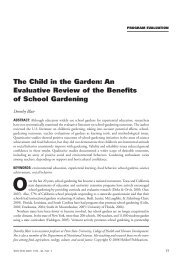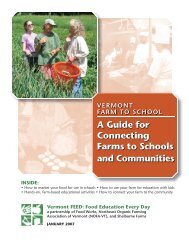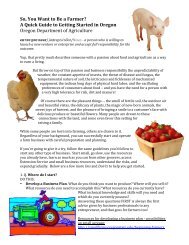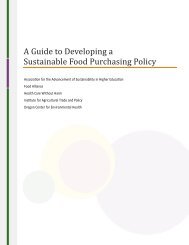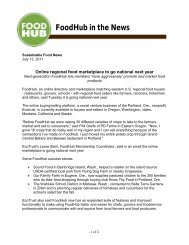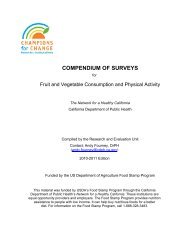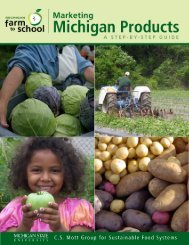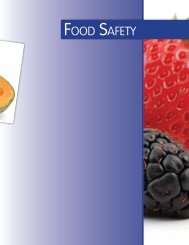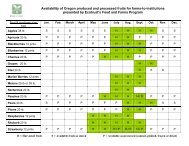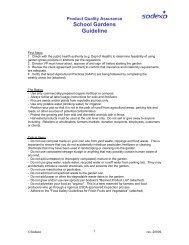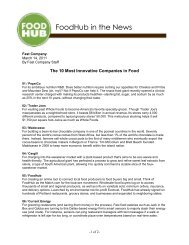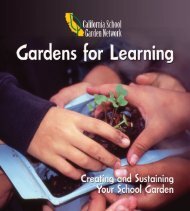eval report cover.indd - New Jersey Farm to School Network Wiki
eval report cover.indd - New Jersey Farm to School Network Wiki
eval report cover.indd - New Jersey Farm to School Network Wiki
Create successful ePaper yourself
Turn your PDF publications into a flip-book with our unique Google optimized e-Paper software.
Comparative Research: Nutrition Education and Student Dietary BehaviorsSmall school-based effectiveness trials increase vegetable and fruit consumption amongyouth. Stables GJ, Young EM, Hower<strong>to</strong>n MW, Yaroch AL, Kuester S, Solera MK, Cobb K,Nebeling L. Journal of the American Dietetic Association. 2005; 105(2): 252-256.Review of <strong>Farm</strong> <strong>to</strong> <strong>School</strong> Evaluation LiteratureTh is review article <strong>cover</strong>ed <strong>eval</strong>uations of 5 A Day program interventions aimed at studentswith a control group and examined the outcome of fruit and vegetable intake. Th e sevenprojects included used a variety of nutrition education approaches including classroomlessons, farmers’ market <strong>to</strong>urs, media campaigns, parent activities, and lunch lessons.Different intervention and <strong>eval</strong>uation components were employed by the various projects.Four of the seven projects showed a signifi c ant change in fruit and vegetable consumption,ranging from +0.2 <strong>to</strong> +0.7 serving net change compared <strong>to</strong> the control groups. Of those fourprojects with signifi c ant changes, three of them are partially due <strong>to</strong> decreased consumptionin the control group, along with increase or no change in the treatment groups.Changes in student behavior<strong>Farm</strong> <strong>to</strong> school programs are based on the premise that students will choose <strong>to</strong> eat moreof healthy foods including fruits and vegetables, if the products are fresh, locally grown,picked at the peak of their flavor, and supplemented by educational activities.Seven studies demonstrated that students participating in farm <strong>to</strong> school programs areoffered more fruits and vegetables. Students subsequently choose the fresh fruits andvegetables, irrespective of whether an alternative meal option is available on that day.Students take more fruits and vegetables from the cafeteria offerings►In 2003-04, digital pho<strong>to</strong>graphs of students’ meal trays at the Crunch LunchProgram in Davis, CA (CLP-CA) were used <strong>to</strong> gather data about what childrenwere consuming from the salad bar meals. 18 Data revealed that farm <strong>to</strong> schoolsalad bars increased fruit and vegetable consumption with students taking morethan the USDA minimum requirement. i In 2004-05, plate waste studies wereundertaken <strong>to</strong> determine how much of the fruits and vegetables taken on thetrays were actually consumed by the students. 19Th ese studies were limited <strong>to</strong> data collection at three schools in the district that operatea comprehensive waste management and recycling program. The plate waste study resultsshowed that, on average, 49% of fruits and vegetables served at the salad bar wereconsumed, compared <strong>to</strong> 66% of fruits and vegetables served through the hot lunch.However, it is important <strong>to</strong> note that on two out of three hot lunch days, apple juice accountedfor approximately 50% of the <strong>to</strong>tal count of fruits and vegetables consumed. Inaddition, on salad bar days, about 85% of students <strong>to</strong>ok servings of fruits and vegetables,whereas at the hot lunches, only about 35% of children served themselves fruits andvegetables. The fruits and vegetables taken by students from the salad bar were 80-90%raw or unprocessed, whereas the fruits and vegetables taken from the hot lunch were80-90% processed.iUSDA <strong>School</strong> Meals Initiative for Healthy Children is based on Food Based Menus. With Food BasedMenus, foods from specific food groups and in specifi c quantities must be offered. The minimum USDArequirement in the meal component of Vegetables/Fruits for grades K-6 is two or more servings ofvegetables and/or fruits, which is equivalent <strong>to</strong> 3/4 cup per child per day plus 1/2 cup extra over a week.32 Bearing Fruit: <strong>Farm</strong> <strong>to</strong> <strong>School</strong> Evaluation Resources and Recommendations



